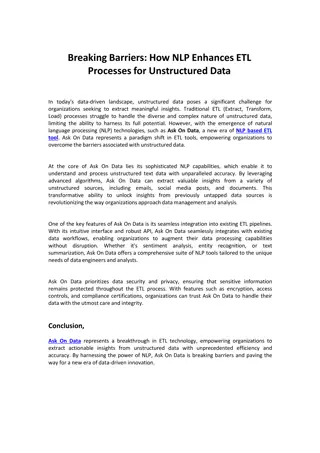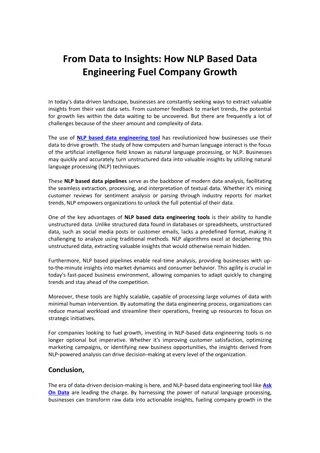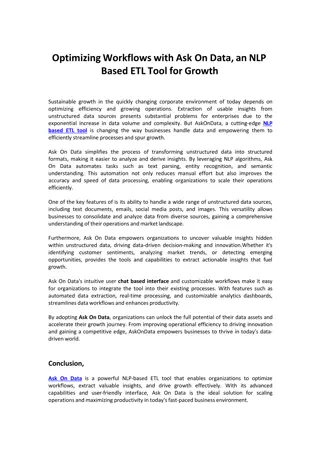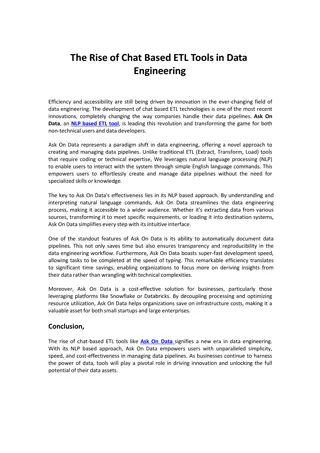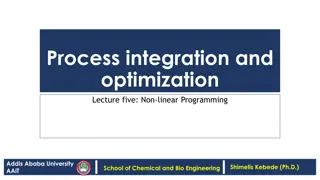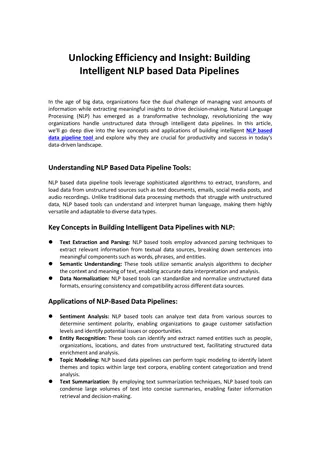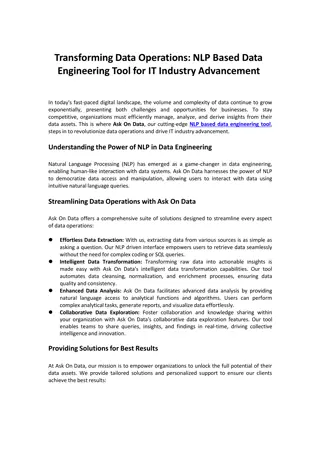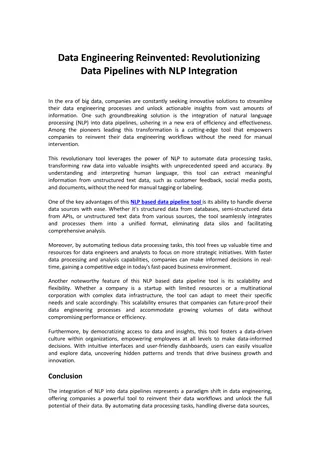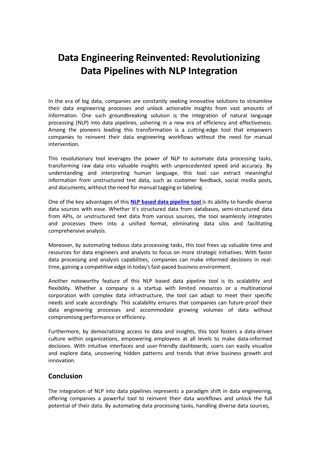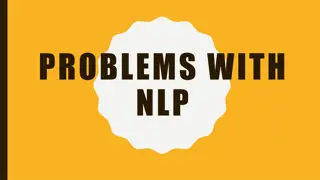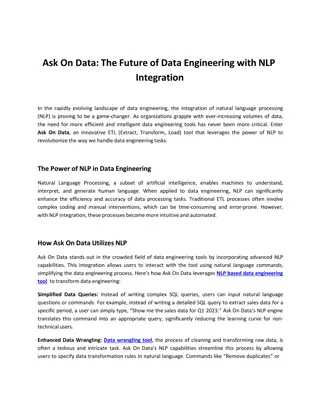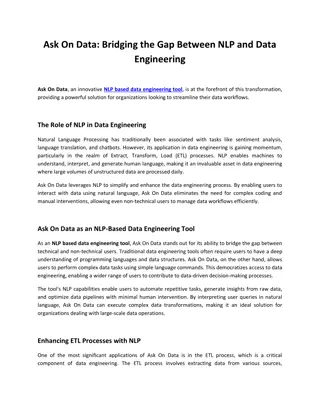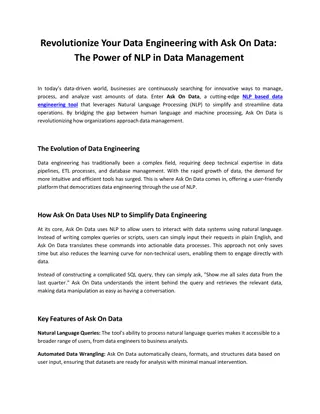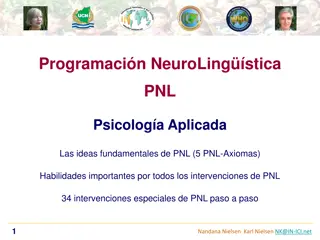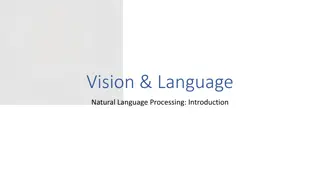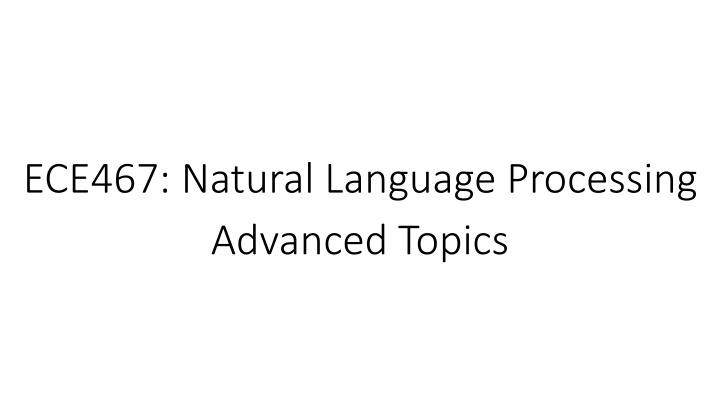
Challenges and Solutions in Language Processing
Explore the drawbacks of word embeddings, out-of-vocabulary words, and the use of subwords in modern NLP. Learn about solutions to handle OOV words and enhance word embeddings through subword mapping.
Download Presentation

Please find below an Image/Link to download the presentation.
The content on the website is provided AS IS for your information and personal use only. It may not be sold, licensed, or shared on other websites without obtaining consent from the author. If you encounter any issues during the download, it is possible that the publisher has removed the file from their server.
You are allowed to download the files provided on this website for personal or commercial use, subject to the condition that they are used lawfully. All files are the property of their respective owners.
The content on the website is provided AS IS for your information and personal use only. It may not be sold, licensed, or shared on other websites without obtaining consent from the author.
E N D
Presentation Transcript
ECE467: Natural Language Processing Advanced Topics
Subtopic #1 Subword Embeddings
Drawbacks of Word Embeddings We have examined word embeddings, which can be pre-learned using a method such as a word2vec model Word embeddings can be fed as input to neural networks, including variations of RNNs (including LSTMs), encoder-decoder models, etc. However, word embeddings have drawbacks Based on an earlier draft of the textbook, some of the drawbacks are: Some languages have too many words to realistically learn word embeddings for all variations (e.g., morphologically complex languages) Word embeddings ignore morphological information (I add: although the book listed this as a drawback, I consider this debatable) Some languages do not contain spaces between words, making tokenization at the word level difficult (not mentioned in the book) Even for standard languages, some words will occur that do not have pre-learned embeddings (this is discussed further on the next slide)
Out-of-vocabulary words Regardless of the reason they occur, words that have not been seen in a training set are called out-of-vocabulary (OOV) words The textbook discusses OOV words in the chapter on N-grams, and we also mentioned them in that context Reasons for this include new words introduced to the language (neologisms), misspellings, and borrowings from other languages It is also common for named entities to introduce new terms; e.g., people, organizations such as companies, names of games, etc. Words that are borrowed from other languages are sometimes called loanwords A related notion is transliteration, when a word from one language is converted to another alphabet, attempting to keep the pronunciation the same When a system that uses only word embeddings encounters an OOV word, it generally needs to do something hacky
Subwords In modern NLP, many works map smaller pieces of words, generally referred to as subwords, to embeddings An earlier draft of the textbook discussed this subtopic (briefly) in a section that was titled "Words, Subwords and Characters" The book (earlier draft) mentions three approaches for choosing which subwords to use for embeddings Individual characters can be mapped to character embeddings We can use subwords created by byte-pair encoding (BPE), or some alternative method A system can "use full-blown morphological analysis to derive a linguistically motivated input sequence" Another approach to dealing with subwords that become popular in recent years is known as fasttext The book (current draft) has one paragraph on fasttext in Section 6.8.3, but we will not cover this approach
Byte-pair Encoding Overview Byte-pair encoding (BPE) was originally developed for use as a compression algorithm Our textbook discusses BPE as a method for tokenization in Section 2.4.3 BPE has been around for decades, but it has become popular recently as a method for generating subwords for subword embeddings An alternative method for generating subwords, also briefly mentioned in Section 2.4.3, is called WordPiece; we won't discuss it
BPE Algorithm The BPE algorithm starts with a separate symbol for each character in the text being processed (e.g., every ASCII character or every Unicode character) There is also a special end-of-word symbol, concatenated to the end of each word in the corpus being used to generate the BPE tokens that will be recognized Thus, the initial vocabulary (i.e., recognized set of tokens) is the set of characters in the encoding plus the end-of-word symbol The algorithm then iteratively combines the most frequent sequential pair of symbols to form a new symbol The new symbol gets added to the vocabulary Words containing the new symbol are updated in the corpus being processed This proceeds for a fixed number of iterations, k, where k is a parameter of the algorithm The algorithm only considers pairs of symbols within words (i.e., not crossing word boundaries) We will step through an example to help explain this
BPE Example: Initial State We will step through an example from textbook to help explain this The example is based on a corpus with 5 distinct words, 18 total instances of words, and initially 11 distinct symbols (including the end-of-word symbol, represented as an underscore) Initially, the vocabulary consists only of the 11 original symbols, and the counts of all the words is known
BPE Example: Step 1 During the first iteration of the algorithm, it is determined that the most frequent symbol pair is 'e' followed by 'r', which occurs 9 times Therefore, a new symbol for 'er' is created and added to the vocabulary All instances of this pair are replaced by the new symbol Note that 'r' followed be '_' ties with this, so that also would have been a valid choice
BPE Example: Step 2 During the second iteration, the most frequent pair is 'er' followed by '_', which occurs 9 times Therefore, a new symbol for 'er_' is created and added to the vocabulary All instances of this pair are replaced by the new symbol Note that 'e', 'r', and 'er' are still members of the vocabulary
BPE Example: Step 3 During the third iteration, the most frequent pair is 'n' followed by 'e', which occurs 8 times This time, a new symbol for 'ne' is created and added to the vocabulary All instances of this pair are replaced by the new symbol Note that 'e' followed be 'w' ties with this, so that also would be a valid choice
BPE Example: Five More Merges The book shows the merged pairs and the updated vocabularies for the next five steps Note that the algorithm remembers the order in which the merges have been generated
Using BPE to Tokenize We can use the result of the BPE algorithm to tokenize future texts as follows: Start with all characters represented by separate symbols Then apply the merges greedily in the order that they were learned Note that when we apply the tokenization, the frequencies in the data being tokenized do not play a role Based on the example, the word "newer" in the document being tokenized would become a single token, "newer_" The word "lower" would become "low er_" (two separate tokens)
BPE Advantages As mentioned earlier, BPE runs for a fixed number of iterations, k This determines the size of the vocabulary, which is typically significantly smaller than the size of a conventional vocabulary The book says that "in real settings BPE is run with many thousands of merges on a very large input corpus" The book claims that "most words will be represented as full symbols, and only the very rare words (and unknown words) will have to be represented by their parts" This is a bit different from what I ve learned about the algorithm; I learned that: Common words (e.g., "the") will be represented as single symbols Common morphemes (e.g., "un-", "-ies", etc.) will be represented as single symbols BPE can achieve something similar to morphological parsing with a much simpler algorithm, hopefully leading to sensible tokens OOV words are likely to be tokenized into meaningful chunks
Using Subword Embeddings Once it is determined what subwords will be used, embeddings for the subwords can be learned (pre-trained) using any standard method One way to apply subword embeddings to a task is to simply feed them in as input to any variation of an RNN There have been many systems that have successfully used this approach Another idea is to build word embeddings out of subword or character embeddings Optionally, these built-up word embeddings can be combined with, or used in place of, standard word embeddings
Using Character Embeddings: Example An alternative to using word embeddings or subword embeddings is to use character embeddings The figure on the next page (from an earlier draft of the textbook) helps to explain an example of how character embeddings could be used for a sequence labelling task The Bi-RNN near the bottom, which is combining character embeddings to form a word embedding, is learning how to do this in the context of the current task That is, the original character embeddings have been pre-trained, but the way in which they are combined is being learned for a specific sequence labelling task Ultimately, the hidden states from the ends of the two directions of the bidirectional RNN are combined to form a character-level word embedding This character-level word embedding is being combined with a conventional word embedding; e.g., using concatenation When an OOV word is encountered, the character-level word embedding can be used on its own The higher blue box labeled "RNN" can represent any variation of RNN (e.g., an LSTM), possibly stacked or bidirectional This figure helps to intuit why character embeddings can be useful
Subtopic #2 Question Answering (QA)
Question Answering Overview Question answering (QA) refers to the task of finding a specific answer to a given question within a text corpus or a knowledge base QA is covered in Chapter 14 of the current draft of the textbook We will focus on QA involving a text corpus, such as the World Wide Web A first phase of such a system would apply information retrieval (IR) techniques to retrieve documents that are likely to contain an answer to the given question We covered IR as part of our first unit of the course IR-based question answering has been worked on a long time, and conventional, statistical approaches worked fairly well Deep learning has significantly improved one component of the task The primary focus of the task has generally been answering factoid questions This basically means that the answer is a short span of text (often, but not always, a named entity) The figure on the next slide shows examples of factoid questions and their answers
Pre-neural, IR-based, Factoid QA Systems We will take an excursion to discuss methods used by conventional (pre-neural), statistical, IR-based factoid QA systems, which often consisted of several independent components The figure on the next slide (from an earlier draft of the textbook) shows a possible architecture for such a system The "Document Retrieval" component represents a typical IR system However, the task of QA is different than IR; we are tasked with finding the specific answer The "Passage Retrieval" component splits each document into paragraphs or other smaller snippets to serve as passages in which we the system searches for answers Some conventional systems would then search for answers in every passage Others choose candidate passages using a statistical ML approach; features used might include: The number of named entities of the right type in the passage The number of keywords or N-grams that overlap between the passage and the question The longest exact sequence of question keywords that occurs in the passage The rank of the document from which the passage was extracted The proximity of the keywords from the original query to each other We will discuss other components of a conventional, IR-based system on future slides
Question Processing for Conventional QA The "Query Formulation" component takes the user's question and formulates a query for the IR system For web searches, the questions might be used as queries without modification For smaller corpora, using bigrams might be helpful, and query expansion might be helpful Some systems applied query reformulation rules, reordering words in such a way that they will more likely match the order in the discovered answer For example, given the question "Where is the Valley of the Kings?", the component may produce the query "the Valley of the Kings is located in" Pre-neural systems also often contained an "Answer Type Detection" component that would analyze the question to determine a category for the desired answer (e.g., a person, a location, definition, etc.) Sometimes, manual rules were used for this, but more often, supervised machine learning was used, trained on a set of questions with manually labelled answer types Features used by conventional, statistical systems included words, their POS, and named entities Some systems gave the head of the noun phrase following the wh-word in the question high weight; for example, consider questions starting "Which city " or "What is the state flower " If the answer type is a specific type of named entity, only passages containing at least one instance of such a named entity need to be considered by the system
Answer Extraction for Conventional QA The "Answer Extraction" box in the diagram represents the component of a system that examines one passage at a time and tries to find the answer to the original question If the answer type is a named entity, NER can be used to find possible answers of the right type On the other hand, if the question asks for a definition of something, it is more complex to find the exact span of text that specifies the answer Pre-neural systems used either hand-crafted rules (sometimes involving regular expressions) or statistical machine learning techniques Pre-neural, machine-learning-based answer extraction relied on various features (we won t go over them) A method called n-gram tiling looks for common n-grams across passages from highly ranked documents and uses manual scoring rules based on the answer type We will soon see that modern QA systems typically rely on deep learning for this component of QA
Watson Section 14.6 of the current draft of the textbook discusses the approach used by the Watson DeepQA system This is the name of the IBM system that beat two of the best-ever players at Jeopardy! In 2011 Watson could find answers (well ) in both text and knowledge bases Like traditional QA systems, it used several components acting together, and involved sequential phases of processing We won't discuss the details of this system
Reading Comprehension and SQuAD Much of the current research related to QA limits the task to finding an answer to a given question in a specific passage This subtask of QA is sometimes referred to as answer extraction or reading comprehension One important dataset for reading comprehension is the Stanford Question Answering Dataset (SQuAD) The dataset consists of passages from Wikipedia and associated questions Questions were collected from human volunteers The answers are spans of texts from the passages The original SQuAD dataset, SQuAD 1.1, contained only answerable questions SQuAD 2.0 also includes unanswerable questions Each answerable questions contains answers from at least three humans The figure on the next slide shows a passage from SQuAD 2.0 along with three sample questions and their answers
SQuAD Metrics Systems are evaluated according to two metrics Exact match only credits a system if the answer exactly matches one of the human answers F1 combines the precision and recall of predicted answers on a per token basis (we covered these metrics earlier in the course) Stanford maintains a leaderboard, displaying the top systems When Stanford switched from SQuAD 1.1 to SQuAD 2.0, both metrics dropped significantly Now, even for SQuAD 2.0, the top systems beat human performance (but I think this always has to be taken with a grain of salt)
Neural QA Systems The neural component of a QA system processes a question and a passage that contains (or may contain) the answer For each word in the passage, it predicts how likely the word is to be the start of, and how likely the word is to be the end of, the answer to the question These probabilities can be used to predict the answer, or to decide that the passage does not contain the answer to the question We will examine the architecture of a system called DrQA, from 2017, that is built on top of LSTMs The figure on the next slide, from an earlier draft of the textbook, helps to explain the architecture of the system (the few slides after that provide more details) The current draft summarizes the typical architecture of newer systems built on top of BERT and Transformers (we will learn more about these concepts in our remaining subtopics) Some new systems are likely even more complex, and would perform even better, but the example we are discussing should give us a good idea of how neural QA systems work in general Neural QA systems (which really just perform answer extraction), such as the one we will discuss, can be trained end-to-end, using a dataset such as SQuAD, using gradient descent and backpropagation
DrQA: Question Processing Each question is represented by a vector, q This vector is a weighted sum of the hidden states produced by a Bi-LSTM applied to GloVe embeddings of the question words: ? = ????? The weights, bj, are "a measure of the relevance of each question word", relying on a "learned weight vector w" given by: ??= ??? ? ?? ? ??? ? ? ? The system learns during training which question words to weigh the highest Hidden states that correspond to significant question words are weighted higher
DrQA: Passage Processing For each word in the passage, a complex vector is being formed consisting of a concatenation of: The GloVe embedding of the passage word A representation of the POS of the word A representation of the NER tag of the word An exact match feature, representing if the passage word occurs in the question A vector created using an attention mechanism, comparing the passage word's GloVe embeddings to the embeddings of every question word These vectors are input to a Bi-LSTM, producing hidden states for each word in the passage
DrQA: Predicting Probabilities The hidden state for each word in the passage along with with the question representation are used to predict two probabilities: pstart(i) is the probability that the ithword in the passage is the start of the answer pend(i) is the probability that the ithword in the passage is the end of the answer If it is known that the passage contains the answer, the most likely answer can be selected If some questions may be unanswerable, the system must ensure that the likelihood of the answer passes some threshold
Subtopic #3 Transformers
Pre-Transformer Brief Recap Through 2017, variations of RNNs (such as LSTM's) dominated the NLP literature Encoder-decoder networks a.k.a. sequence-to-sequence (seq2seq) models, were used for tasks such as machine translation (MT) Input sequences (represented using either word embeddings or subword embeddings) would be mapped to output sequences These methods produced significantly better results than were possible using pre-neural methods The concept of attention, which allows the decoder to focus on the portion of the output from the encoder that seems most relevant at each time step, improved results further Other NLP researchers had been experimenting with convolutional neural networks (CNNs) CNNs were successful for some text categorization tasks, for example, especially those involving short text sequences such as single sentences or tweets For MT, CNNs were sometimes used for encoders We are not covering CNNs in this course
Shortcomings of RNNs and CNNs RNNs (including the variations such as LSTMs) cannot be efficiently parallelized They must process input sequentially This leads to very slow training CNNs have problems detecting long-distance dependencies This refers to relationships between elements that exist far apart in an input sequence Theoretically, with enough layers, CNNs can handle this, but in practice, they don t work well when long-distance dependencies are significant
Transformers In December 2017, a paper titled "Attention is All You Need" was published by a group of researchers from Google The paper appears in the 2017 Proceedings of the Conference on Neural Information Processing Systems The paper is freely available online (there are at least two slightly different versions) The paper introduces a new neural architecture called a Transformer (not always capitalized in all sources, and I am not entirely consistent with that) A Transformer relies "solely on attention mechanisms, dispensing with recurrence and convolutions entirely" (from the Abstract of the original paper) The current online draft of the textbook discusses self-attention and Transformers in Section 10.1, titled "Self-Attention Networks: Transformers" Section 10.2 discusses how transformers can be used for language modeling The textbook briefly discusses Transformers in the context of encoder-decoder networks, which is how they were described in the original paper, in Section 13.3 I have based my slides for this topic mostly on the original paper, as well as a few websites that help to explain Transformers All figures and tables in this subtopic come from the original paper
Transformer Architecture A Transformer (as it was originally introduced) is an example of an encoder-decoder network The encoder and decoder both rely on stacked layers Each layer has sublayers Some of the sublayers rely on a concept called self- attention (which we will discuss soon) Others are point-wise (a.k.a. position-wise), fully- connected, feedforward NNs The decoder also uses another form of attention applied to the encoder output Note that several later works relying on Transformers only use the encoder portion Some others use only the decoder portion We are covering Transformers as explained in the paper, for sequence-to-sequence (seq2seq) tasks
Attention (as explained in the article) The article describes attention (in general) is being related to queries, keys, and values All of these are vectors, and at least the queries and keys have the same dimension, dk The queries and keys are the things being compared, and the values are the things being combined based on the results of the comparisons In different contexts, two or even all three of these may be identical The Transformer architecture described in the article uses scaled dot- product attention: ??? ????????? ?,?,? = ??????? ? ??
Multi-head Attention Attention learns to focus on one aspect of the input For many NLP tasks, there are various aspects of the input that we need to pay attention to for different reasons For this reason, Transformers use multi-head attention First, queries, keys, and values are linearly projected using learned mappings Next, attention is applied in parallel to each result The outputs or attention are then concatenated and again projected The figure on the next page helps explain the difference between ordinary scaled dot-product attention and multi-head attention
The Transformers Encoder The Transformer s encoder accepts the input, which is a sequence of input embeddings combined with positional encodings (to be discussed soon) The encodings go through 6 identical layers, each containing two sublayers The first sublayer is a multi-head self-attention layer Each encoding is compared to every other, and the weighted encodings are added together to form an output representation (i.e., the query, keys, and values are all the same) A residual connection, a.k.a. skip connection, adds the input of the sublayer to its output; the sum is normalized The second sublayer is a position-wise fully-connected feedforward neural network This consists of "two linear transformations with a ReLU activation in between": FFN(x) = max(0, xW1+ b1)W2+ b2 Weights are shared across positions within a layer, but the weights differ between layers As with the first sublayer, a residual connection adds the input of the sublayer to its output, and the sum is normalized
Positional Encodings Without positional encodings, there is no way for a Transformer to make use of the order of the input It is therefore necessary to "inject some information about the relative or absolute position of the tokens in the sequence" The article says that they experimented with two forms of positional encodings, which led to nearly identical results They wound up using "sine and cosine functions of different frequencies", producing vectors of the same dimension as the embeddings These position encodings are added to the input embeddings Note that positional encodings are only added to the input directly However, due to residual connections, they have an effect throughout the stack
The Transformers Decoder The Transformer s decoder also accepts its inputs (the outputs of the seq2seq mapping), which is a sequence of embeddings combined with positional encodings As with the encoder, the encodings go through 6 identical layers, each containing two sublayers As with the encoder, the first sublayer is a multi-head self-attention layer Unlike the encoder, this sublayer is masked (to be discussed soon) The third sublayer of the decoder is the same as the second sublayer of the encoder (i.e., a position-wise fully-connected feedforward neural network) The second sublayer of the decoder "performs multi-head attention over the output of the encoder stack" Note that this is the same sort of attention we learned about in a previous topic, when discussing LSTMs or other types of RNNs used for encoder-decoder networks The output of the decoder is fed through a linear transformation layer and then a softmax is applied to predict outputs
Training Transformers for Machine Translation The article discusses the results of applying their Transformer architecture to the task of machine translation (MT) Although they don t say it anywhere in the article, the network can be trained end-to-end using stochastic gradient descent and backpropagation Using a parallel corpus, sentences from the source language are fed to the encoder while translations in the target language are fed to the decoder The target sentences are "shifted right", and a start-of-sentence marker is inserted as the new first token (the latter point is not mentioned in the article) They "modify the self-attention sub-layer in the decoder stack to prevent positions from attending to subsequent positions" This masking, combined with the right-shifting, "ensures that the predictions for position i can depend only on the known outputs at positions less than i"
Applying a Trained Transformer to MT It is not mentioned anywhere in the article, but to apply the pre-trained network, you need to run the decoder sequentially, i.e., to predict one token at a time I found a helpful explanation here: https://medium.com/inside-machine- learning/what-is-a-transformer-d07dd1fbec04 During the first run, you feed in the source sentence to the encoder, and only a start-of-sentence symbol to the decoder You only remember the first predicted symbol of the output During the second run, you feed in the source sentence to the encoder, and the start-of-sentence symbol plus the first predicted symbol from the previous step You remember the second predicted symbol of the output for the next step, etc. You repeat this process until and end-of-sentence symbol is predicted
Experiments In the article, the authors discuss their results applying a Transformer for two MT tasks: One task used the WMT 2014 English-German dataset The other task used the larger WMT 2014 English-French dataset For the English-German dataset, they used byte-pair encoding (BPE) for tokenization; we covered BPE during an earlier subtopic This led to about 37,000 distinct tokens in the vocabulary For the English-French datasets, they used "a 32,000 word-piece vocabulary" This involves another algorithm for creating subwords; we will not discuss it further The article discusses what hardware they used and what hyperparameters they used (e.g., the Adam optimizer, dropout, etc.) They tried using a baseline Transformer as well as a "big" version with larger vectors, more heads, etc. The table on the next slide (from the paper) shows that Transformers beat all previous architectures for both translation tasks, achieving state-of-the-art results "at a fraction of the training cost" Since the publication of this paper, Transformers and extensions of Transformers have been applied to many NLP tasks with a lot of success
Subtopic #4 Contextual Embeddings and Large Language Models


